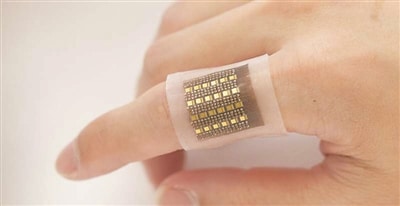This provides medical professionals with unprecedented access to critical information that can help detect life-threatening diseases such as malignancies, organ dysfunction, brain or intestinal bleeding, and more. The research results were published in the journal Nature Communications on the 15th.
The amount and location of hemoglobin in the body provides key information about blood perfusion, or accumulation, at a particular location, the researchers said. Low blood perfusion in the body may lead to severe organ dysfunction, which is related to heart attacks and vascular diseases of the extremities. Abnormal blood accumulation in the brain, abdomen or cysts may indicate cerebral hemorrhage, visceral hemorrhage or malignant tumors. Continuous monitoring can help diagnose these conditions, allowing timely life-saving interventions.
This new, flexible, small-form-factor wearable patch fits comfortably on the skin for non-invasive long-term monitoring. It enables three-dimensional mapping of hemoglobin in deep tissue with submillimeter spatial resolution, down to a few centimeters below the skin, whereas other wearable electrochemical devices typically only sense biomolecules at the skin surface. It also enables high contrast with other tissues. Due to its optical selectivity, it can expand the range of detectable molecules and potential clinical applications by integrating different laser diodes with different wavelengths.
The patch is equipped with an array of laser diodes and piezoelectric transducers in its soft silicone polymer matrix. The laser diode emits pulsed laser light into the tissue, the biomolecules in the tissue absorb the light energy and radiate the sound waves into the surrounding medium, the piezoelectric transducer receives the sound waves, and the sound waves are processed in the electrical system to reconstruct the wave emitting biomolecules space mapping.
It is also much safer than X-ray technology with ionizing radiation, given its low-power laser pulses. The research team plans to further develop the device, including shrinking the back-end control system into a portable device for laser diode driving and data acquisition, greatly expanding its flexibility and potential clinical utility. (Reporter Zhang Mengran)
【spacesrobot point of view】
Life-threatening conditions often progress very rapidly. But before an irreversible situation occurs, is there a special time period that can “ring the alarm bell”? Research has shown that continuous monitoring of deep hemoglobin can do just that. The new device in this paper, with a very simple patch method, has great potential in closely monitoring high-risk groups. In the future, this electrochemical-based device can also be used to monitor more biomolecules, making it a good candidate for long-term wearable monitoring applications.




GIPHY App Key not set. Please check settings